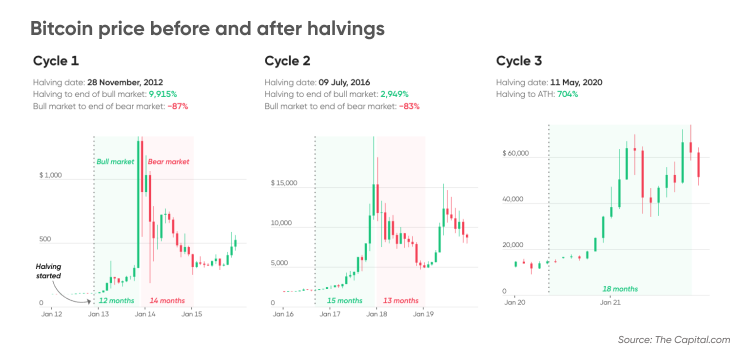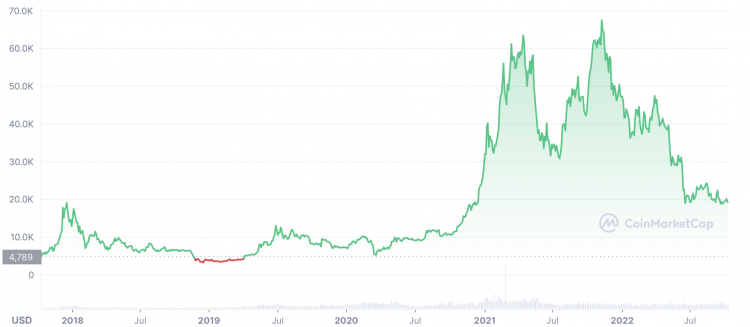Is Bitcoin Price Gonna Continue to Rise

Bitcoin (BTC) has struggled to maintain much of a position above $20,000 over the last few months, sinking below that level throughout much of late September and early October 2022, having recovered after falling to a 19-month low of $17,708.62 in June.
The value of Bitcoin remains a far cry from its all-time high of $68,789.63, reached in November 2021. Market observers have had to recalibrate their expectations – many had predicted that the coin was on its way to $100,000, a Bitcoin price forecast that now seems incredibly optimistic – with many forecasters lowering their Bitcoin projected values, at least in the short term.
What has driven the volatility in the Bitcoin price, and what are the latest Bitcoin projections as of 11 October 2022? Let's see what we can find out.
How does Bitcoin work?
Bitcoin is a decentralised digital currency that was created in 2008 by an anonymous developer going by the name Satoshi Nakamoto. Bitcoin is mined and distributed on a peer-to-peer digital ledger called a blockchain, which uses cryptography to validate and process transactions.
Bitcoin was officially launched in January 2009 when the first block, known as the genesis block, was mined on the blockchain.
Each new block contains a proof-of-work (PoW) protocol to be accepted by the network – miners use computer processing power to verify the cryptographic hashes in each block. As a reward for mining a new block, miners receive transaction fees from the block as well as a set number of newly generated Bitcoins (BTC).
Bitcoin was designed to have a maximum circulating supply of 21 million coins, with the mining reward of new coins reduced by half after every 210,000 blocks are mined, in an event known as the "halving". The most recent halving occurred on 11 May 2020, reducing the block reward to 6.25 BTC. The next halving will take place in 2024.
As of 11 October 2022 there were a little under 19.2 million Bitcoins in circulation. With the halving events reducing the creation of new coins, it is expected to take until 2140 before the full 21 million BTC are in circulation.
Bitcoin price history
Let's now take a look at some of the Bitcoin price history. While past performance should never be taken as an indicator of future results, knowing what the coin has done over the last few years can help give us some much needed context if we want to either make our own BTC price prediction or interpret one that is already out there.
The capped supply aims to maintain Bitcoin's scarcity, increasing its value over time as an inflationary asset, as usage increases while availability remains fixed. The Bitcoin price has soared around the time of previous halvings, jumping from $12 at the time of the first halving in November 2012 to over $1,000 a year later, and climbing from $650 at the time of the second halving in July 2016 to $20,000 in December 2017.
Following the 2020 halving, the BTC price soared from around $9,000 to the November 2021 peak.

Given Bitcoin's inflationary nature, it became popular among retail investors as a form of "digital gold". It was viewed as a safe haven asset offering portfolio diversification and a hedge against falling prices for other financial assets such as stocks and bonds.
But as more investors have entered the market and involvement from institutional investors has grown, Bitcoin has gradually become more correlated to stock markets.
The 2017 cryptocurrency rally saw the Bitcoin price soar from around $1,000 at the start of the year to a new high of $20,000 in mid-December of that year. A sharp sell-off in 2018 pulled the BTC price down to $8,000 in little more than a month, and below $4,000 by the end of the year.
Bitcoin peaked at $13,129.53 in July 2019, but it was in 2020, after an initial sell-off across most financial assets in March, that the BTC price took off. With the halving in May 2020 and rising interest from investors, Bitcoin ended the year at $29,000 and continued to rally in 2021.
Bitcoin rallied above $64,000 in mid-April 2021, leading a rally across the growing number of altcoins, or alternative cryptocurrencies. The price fell to a low of $29,360.96 on 20 July 2021, then began to rebound over the summer on its way to the all-time high in November.
But profit taking and mass sell-offs gave way to a new bear market at the end of last year, with Bitcoin trading down to $46,000 at the end of December 2021.

How has Bitcoin performed in 2022?
The decline continued and the Bitcoin price dropped to $33,184.06 on 24 January 2022. The market attempted to recover, rising to $45,661.17 on 10 February, but retreated to $34,459.22 just two weeks later when Russia's invasion of Ukraine put investors back into risk-off mode. Bitcoin bounced to $48,086.84 on 28 March, but it was unable to hold on to the gains.
The Bitcoin price dropped to a low of $26,350.49 on 12 May — the day when the US dollar index reached a then-20-year high and the Terra cryptocurrency crashed, driving bearish sentiment and prompting investors to withdraw their funds from cryptocurrencies into dollars.
Bitcoin briefly traded above $31,000 heading into June as the market responded to the Terra collapse, but another rapid sell-off brought the price down to $17,708.62 on 18 June. The price has since bounced above $20,000 three times before dropping back, reaching $24,196.82 on 20 July 2022.
The cryptocurrency markets are being buffeted by several external as well as internal factors. The collapse of the TerraUSD stablecoin and Luna token was followed by the bankruptcy of the Three Arrows Capital cryptocurrency hedge fund at the end of June.
Cryptocurrency broker Voyager Digital, which had lent funds to Three Arrows, filed for its own Chapter 11 restructuring on 5 July 2022. On 13 July, cryptocurrency lending platform Celsius Network filed for Chapter 11.
The contagion continued to spread, as Singapore-based Zipmex halted withdrawals from 20 July until 22 July – a move that also preceded the bankruptcies of Voyager and Celsius as well as Vauld, another Singapore-based platform that filed for restructuring on 8 July after suspending withdrawals four days earlier.
Bitcoin dropped below $23,000 on 21 July 2022, after electric vehicle maker Tesla said in its second-quarter financial report that it had liquidated 75% of its BTC purchase holdings during the quarter for $936m in cash.
"Yes, actually, it should be mentioned that the reason we sold a bunch of our Bitcoin holdings was that we were uncertain as to when the Covid lockdowns in China would alleviate. So, it was important for us to maximise our cash position, given the uncertainty of the Covid lockdowns in China. We are certainly open to increasing our Bitcoin holdings in future, so this should not be taken as some verdict on Bitcoin. It's just that we were concerned about overall liquidity for the company," Tesla CEO Elon Musk said on the company's earnings call.
Since then, the coin has struggled. On 11 October 2022 it was worth a little over $19,000, giving it a market cap of around $366bn.
Bitcoin has also been affected by uncertainty about the health of the global economy, with inflation running at 40-year highs in some countries and central banks responding with aggressive interest rate hikes. Analysts have indicated that the higher rates could halt economic growth and result in a recession. The US Federal Reserve raised interest rates this year, with the target expected to be around 4% by the end of 2022.
In addition, global supply chains remain under pressure following extended Covid-19 lockdowns in China in recent months, which have hampered industrial activity around the world. These factors have an increasing influence on the Bitcoin price prediction as the correlation between cryptocurrencies and other assets increases.
The S&P 500 Index (US500) of large US company stocks has dropped by about 25% year-to-date (YTD). Bitcoin has been much more volatile, plunging by around 60% since the start of the year.
What do analysts expect in terms of Bitcoin future price moves? How high can Bitcoin go in the current macro environment?
The experts speak
"Bitcoin has lost two-thirds of its value from its high in November 2021, making it the fifth most severe drop in the cryptocurrency's history. This collapse was precipitated by a deterioration in global risk sentiment as a result of the cessation of monetary stimulus and the concomitant rise in global interest rates to combat soaring inflation," said Piero Cingari, an analyst at Capital.com.
"Bitcoin has amplified the losses observed on the stock market, confirming its status as a 'risk-on' asset that is highly sensitive to market sentiment. I don't foresee a big turnaround in the near future since investor sentiment toward risk will remain weak in the face of uncertainties about interest rates and inflation, as well as rising geopolitical concerns. BTC/USD bottom might still be around 15,000 points," Cingari said of the Bitcoin outlook.
"For Bitcoin to begin a new bullish trend, it is necessary to repeat the circumstances that have previously ignited its run, notably a rise in global liquidity and monetary stimulus. However, rising inflation has put central banks in a bind, pushing them to boost interest rates. The onset of a recession with deflationary implications might be a game changer for cryptocurrencies, although this scenario is not currently likely."
Analysis by Glassnode made for a more neutral picture: "Recent weeks have seen an uncharacteristically low degree of volatility in Bitcoin prices, in stark contrast to equity, credit, and forex markets, where central bank rate hikes, inflation, and a strong US dollar continue to wreak havoc. Against this backdrop, Bitcoin has been remarkably stable and has gained ground against many assets on a relative scale."
Michael Saylor, Founder and CEO of MicroStrategy (MSTR) and a firm Bitcoin believer, highlighted that the cryptocurrency has become more "clean and efficient," having improved the sustainable power mix. According to the Bitcoin Mining Council, the Bitcoin mining electricity mix increased to 59.5% sustainable in the second quarter of 2022.
In Q2 2022, #Bitcoin mining efficiency surged 46% YoY, and sustainable power mix reached 59.5%, above 50% for the 5th quarter in a row. The network was 137% more secure YoY, only using 63% more energy. It is hard to find an industry more clean & efficient.https://t.co/gqYn8qew9R
— Michael Saylor⚡️ (@saylor) 19 July 2022
"The future of banking is Bitcoin," said Saylor in a recent tweet, confirming his positive view on the Bitcoin projected value.
Bitcoin price predictions
With that all out of the way, let's now take a look at some of the Bitcoin price predictions that were being made as of 11 October 2022.
It is important to remember at this stage that price forecasts, especially for something as potentially volatile as a cryptocurrency, often turn out to be wrong. Also, many long-term crypto price forecasts are made using an algorithm, which means they can change at a moment's notice.
First,CryptoPredictionshad a Bitcoin price prediction for 2022 that said BTC could close the year at around $19,334.87, before finishing 2023 at $19,433.39. The coin could, if the Bitcoin price forecast holds true, drop down to close 2024 at $18,961.68 and 2025 at $17,517.31, before continuing its slide to $13,916.30 in December 2026.
DigitalCoinPrice's Bitcoin price prediction for 2025 indicated a fast pace of growth, with the price potentially averaging $49,998.68 that year and then hitting $105,638.70 in 2030.
The Bitcoin price prediction for 2030 from PricePrediction was also highly bullish at $413,559.08, up from an already-optimistic $21,236.87 in 2022, $30,558.32 in 2023 and $63,879.64 in 2025.
Finally, WalletInvestor was also positive in its BTC price prediction, saying that the coin could trade at $25,373.90 by 11 October 2023, and suggesting a Bitcoin price target of $47,496.74 in five years' time.
When considering a BTC coin price prediction, it's important to keep in mind that cryptocurrency markets remain extremely volatile, making it difficult to accurately predict what a coin or token's price will be in a few hours, and even harder to give long-term estimates. As such, analysts and algorithm-based forecasters can and do get their predictions wrong.
If you are considering investing in cryptocurrency tokens, we recommend that you always do your own research. Look at the latest market trends, news, technical and fundamental analysis, and expert opinion before making any investment decision. Keep in mind that past performance is no guarantee of future returns, and never trade with money that you cannot afford to lose.
FAQs
Is Bitcoin a good investment?
It is difficult to tell. As the largest crypto out there, BTC is the coin that pretty much decides the fate of the market, so careful research before making a decision is advised. A lot will depend on how the economy as a whole behaves, too.
Remember, you should always carry out your own thorough research before making an investment. Even high market cap cryptocurrencies have proved vulnerable to the current bear market, so investors should be prepared to make losses and never purchase more than they can afford to lose.
Will Bitcoin go up or down?
It is hard to say. While the likes ofDigitalCoinPrice are optimistic, other sites such asCryptoPredictionsare far more downbeat. It is worth noting that price predictions are often wrong and that prices can go down as well as up.
In volatile cryptocurrency markets, it is important to do your own research on a coin or token to determine if it is a good fit for your investment portfolio. Whether BTC is a suitable investment for you depends on your risk tolerance and how much you intend to invest, among other factors. Keep in mind that past performance is no guarantee of future returns, and never invest any money that you cannot afford to lose.
Can Bitcoin reach $100,000?
As of 11 October 2022, some forecasting sites predicted that the bitcoin price could trend higher over time to reach $100,000 at some point around the end of the decade.
It is important to do your own research to take an informed view of which wasy the price could move, remembering that price predictions often get it wrong.
Should I invest in Bitcoin?
This is a question that you will have to answer for yourself. Before you do anything, you should research not only Bitcoin but the wider crypto market and the economy in general.
Never invest more money than you can afford to lose, because prices can go down as well as up.
Related reading


Source: https://capital.com/bitcoin-price-prediction-will-btc-go-up
0 Response to "Is Bitcoin Price Gonna Continue to Rise"
Post a Comment